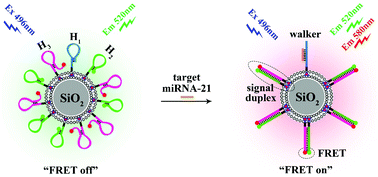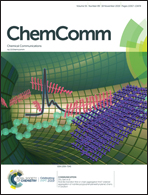A dynamic 3D DNA nanostructure based on silicon-supported lipid bilayers: a highly efficient DNA nanomachine for rapid and sensitive sensing†
Abstract
Herein, by anchoring cholesterol-labelled DNA probes to silicon-supported lipid bilayers via cholesterol–lipid interaction, a dynamic three-dimensional (3D) DNA nanostructure could be facilely assembled, which is applied as a microRNA (miRNA)-induced self-powered 3D DNA nanomachine with high movement efficiency. Once the self-powered 3D DNA nanomachine is triggered by target miRNA, it achieves autonomous operation without external addition of fuel DNA strands or protein enzymes. Impressively, the biocompatible lipid bilayers not only preserve the biological character of the DNA probes, but also improve the movement efficiency of the DNA nanomachine, which directly solves the key challenge of the steric barrier effect of traditional rigid surfaces (Au or silicon) for DNA probe diffusion. As a proof of concept, our proposed DNA nanomachine is successfully applied in rapid and sensitive detection of miRNAs, which gives a new idea for the construction of highly efficient DNA nanomachines for biosensing and clinic diagnosis.



 Please wait while we load your content...
Please wait while we load your content...